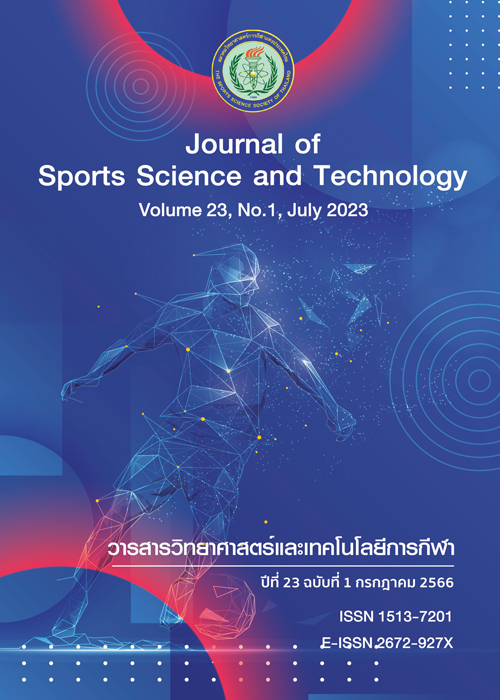DEVELOPMENT OF INFRARED THERMOGRAPHY DETECTION PROGRAM MEASURE MUSCLE SORENESS AFTER EXERCISE IN THAI YOUTH
INFRARED THERMAL DETECTION MEASURE SYMPTOMS MUSCLE AFTER EXERCISE
DOI:
https://doi.org/10.14456/jsst.2023.4Keywords:
Muscle Soreness, Thermal Photograph, High-Intensity Exercise ProgramAbstract
The assessment of soreness due to skin temperature by infrared thermography is a fast, and non-invasive. This study developed thermal infrared imaging software to detect changes in skin temperature in response to inflammation associated with muscle soreness. The participants consisted of 50 healthy, it’s followed a high-intensity exercise to induce muscle soreness. The muscle soreness assessment with infrared thermography of the anterior thigh muscle were before and after exercise. The temperature measurements from the infrared thermography show the quantitative and qualitative average values from the thermal imaging of 50 set of anterior thigh muscle imaging. It was tested by temperature conversion process from the color spectrum of the thermal image. Using the principle of analyzing the color intensity from the thermal imaging spectra. The temperature range used for research was between 36°C to 45°C. The results showed that efficiency test of the program assessing muscular soreness was developed by measuring the accuracy in analyzing the temperature of the thermal spectrum image from the thermal imaging test data of 50 set under the conditions of 10 temperature ranges, the total average was 80 %, and the temperature analysis accuracy of the heat spectrum was good. Testing the thermal imaging accuracy performance without specifying temperature ranges to measure the processing of the developed software. It was found that at the thermal imaging level that was 1°C, the color value used to measure red, green, and blue will have a very small difference in the intensity of the color, causing the measurement to be inaccurate. From testing thermal photographs of 50 images, it was found that there were 40 images in the temperature range of 36°C. The temperature range of 37°C=8 images, 38°C=2 images, and 3 images of Relative Error image data. The mean total accuracy was 75%. In conclusion, this method may be useful for the physiological investigation of transdermal temperature changes to safely and noninvasively. However, applications of this technique still need to be studied in larger samples.
(Journal of Sports Science and Technology 2023; 23(1) 52-65)
(Received: 8 June 2022, Revised: 7 December 2022, Accepted: 9 January 2023)
KEYWORDS: Muscle Soreness / Thermal Photograph/ High-Intensity Exercise Program
*Corresponding author: Sakchai SRISUK
Department of Sports Management, Faculty of Management Sciences and Information Technology,
Nakhon Phanom University, Nakhon Phanom, THAILAND
E-mail: sakchai0072@hotmail.com
References
Connolly Declan AJ, Sayers SP, McHugh MP. Treatment and prevention of delayed onset muscle soreness. J Strength Cond Res. 2003;17(1):197-208.
Stauber WT, Clarkson PM, Fritz VK, Evans WJ. Extracellular matrix disruption and pain after eccentric muscle action. J Appl Physiol. 1990 Sep 1;69(3):868-74.
Alderson JK, Ring EF. Sprite’ high resolution thermal imaging system. Thermal. 1995;1:110-4.
Maclntyre DL, Reid WD, McKenzie DC. Delayed muscle soreness: The inflammatory response to muscle injury and its clinical implications. Sports Med. 1995;20(1):24-40. DOI.10.2165/00007256-199520010-00003
Stewart, Ian B., et al. "Thermal infrared imaging can differentiate skin temperature changes associated with intense single leg exercise, but not with delayed onset of muscle soreness. J Sports Sci Med.,2020;19(3): 469.
Miyama M, Nosaka KA. Influence of surface on muscle damage and soreness induced by consecutive drop jumps. J Strength Cond Res. 2004 May 1;18(2):206-11. DOI: 10.1519/R-13353.1
Goodall S, Howatson G. The effects of multiple cold water immersions on indices of muscle damage. J Sports Sci Med. 2008 Jun;7(2):235-241.
Howatson G, Goodall S, Van Someren K. The influence of cold water immersions on adaptation following a single bout of damaging exercise. Eur J Appl Physiol. 2009 Mar;105(4):615-21.
Pornchaloempong P, Nunak N. Accuracy and precision. Food Network Solution Co., Ltd. Bangkok Thailand. 2012 [Online]. available: htt://www.foodnetworsolution.com/wiki/word/4290/precision/
Waters JC. Accuracy and precision in quantitative fluorescence microscopy. J Cell Biol. 2009;185(7): 1135-48.
Taylor JR. Introduction to error analysis, The study of uncertainties in physical measurements, 2nd ed. University Science Books. 1997.
Metz CE. Basic principles of ROC analysis. In seminars in Nuclear Medicine 1978;8(4):283-298.
Hadžić V, Širok B, Malneršič A, Čoh M. Can infrared thermography be used to monitor fatigue during exercise? A case study. J Sport Health Sci. 2019;8(1):89-92.
Formenti D, Ludwig N, Gargano M, Gondola M, Dellerma N, Caumo A, Alberti G. Thermal imaging of exercise-associated skin temperature changes in trained and untrained female subjects. Ann Biomed Eng. 2013;41(4):863-71.
Al-Nakhli HH, Petrofsky JS, Laymon MS, Berk LS. The use of thermal infrared imaging to detect delayed onset muscle soreness. J Vis Exp. 2012;22(59): e3551.
Zaïdi H, Fohanno S, Polidori G, Taiar R. The influence of swimming type on the skin-temperature maps of a competitive swimmer from infrared thermography. Acta Bioeng Biomech. 2007;9(1):47.
Silva, Yokiny A., et al. "Skin temperature changes after exercise and cold-water immersion." Sport Sci Health 2017;13(1): 195-202.
Ring EF, Ammer K. Standard procedures for infrared imaging in medicine. En: Bronzino JD, editor. Medical Devices and Systems. Boca Raton: CRC Press. 2009.
Selfe J, Kärki AI, Donnelly AE. Use of thermal imaging in sports medicine research: A short report. International Sport Med Journal. 2013;14(2):94-8.
Hildebrandt C, Raschner C, Ammer K. An overview of recent application of medical infrared thermography in Sports Medicine in Austria. Sensors. 2010;10(5):4700-15.






